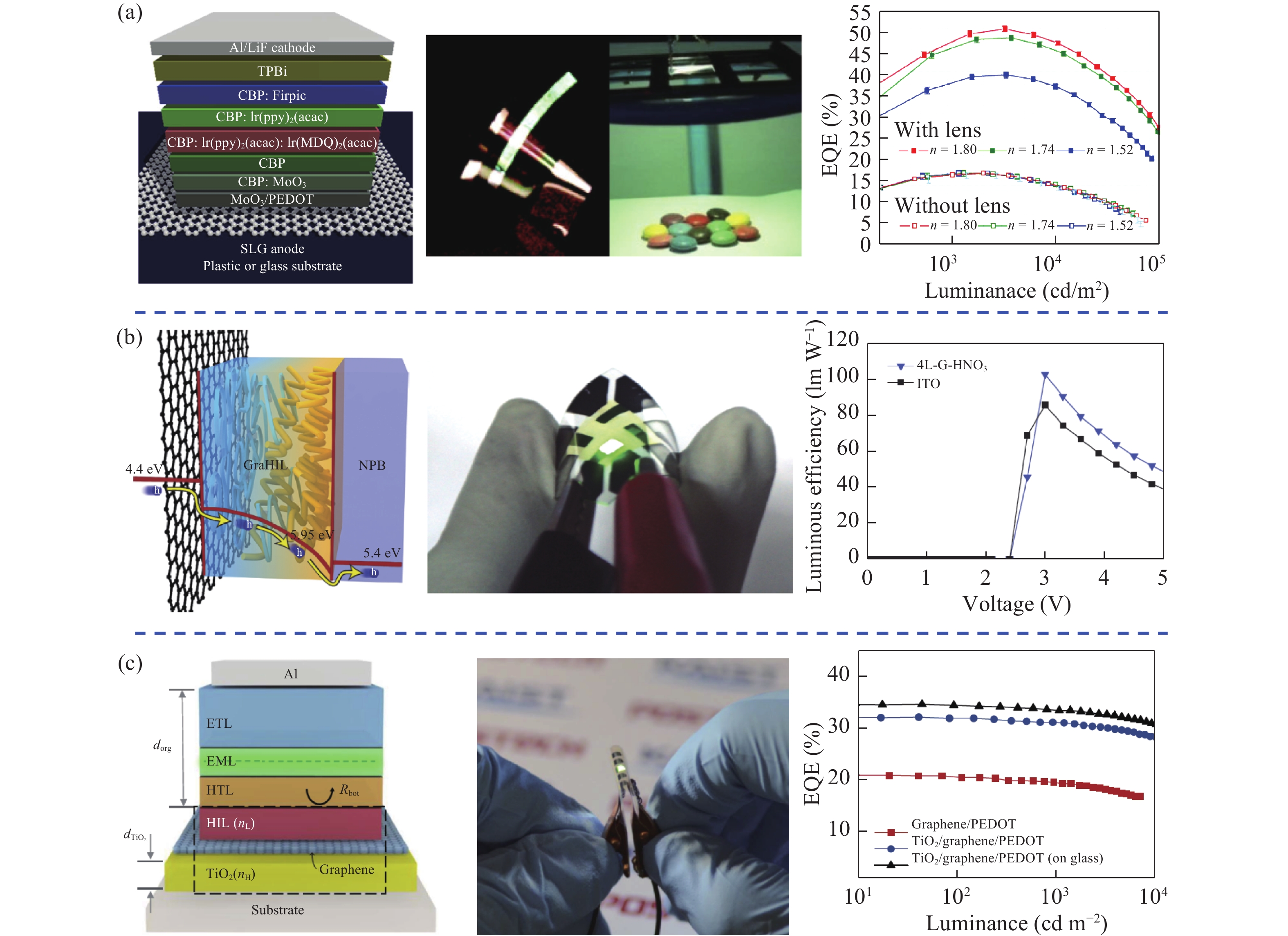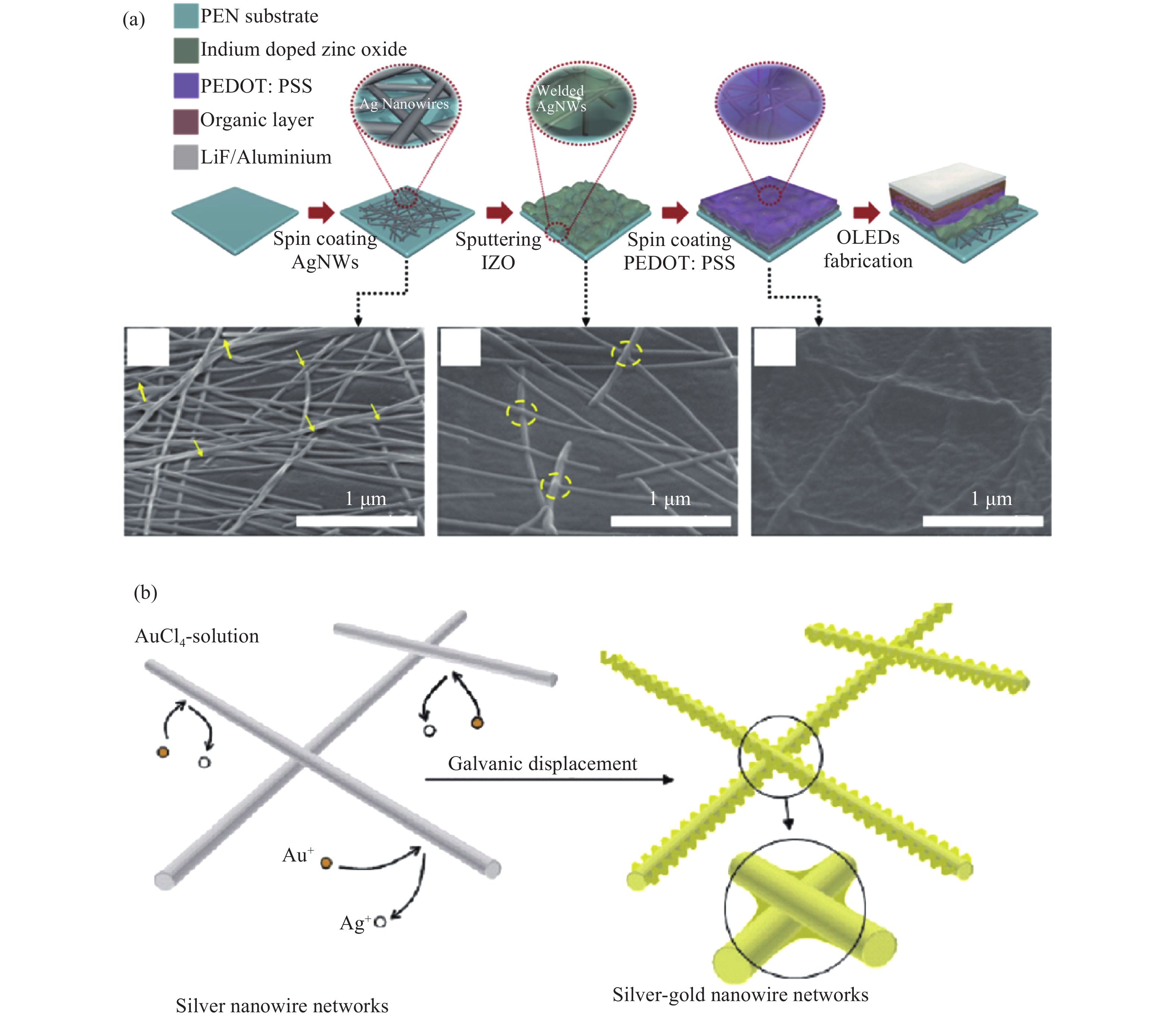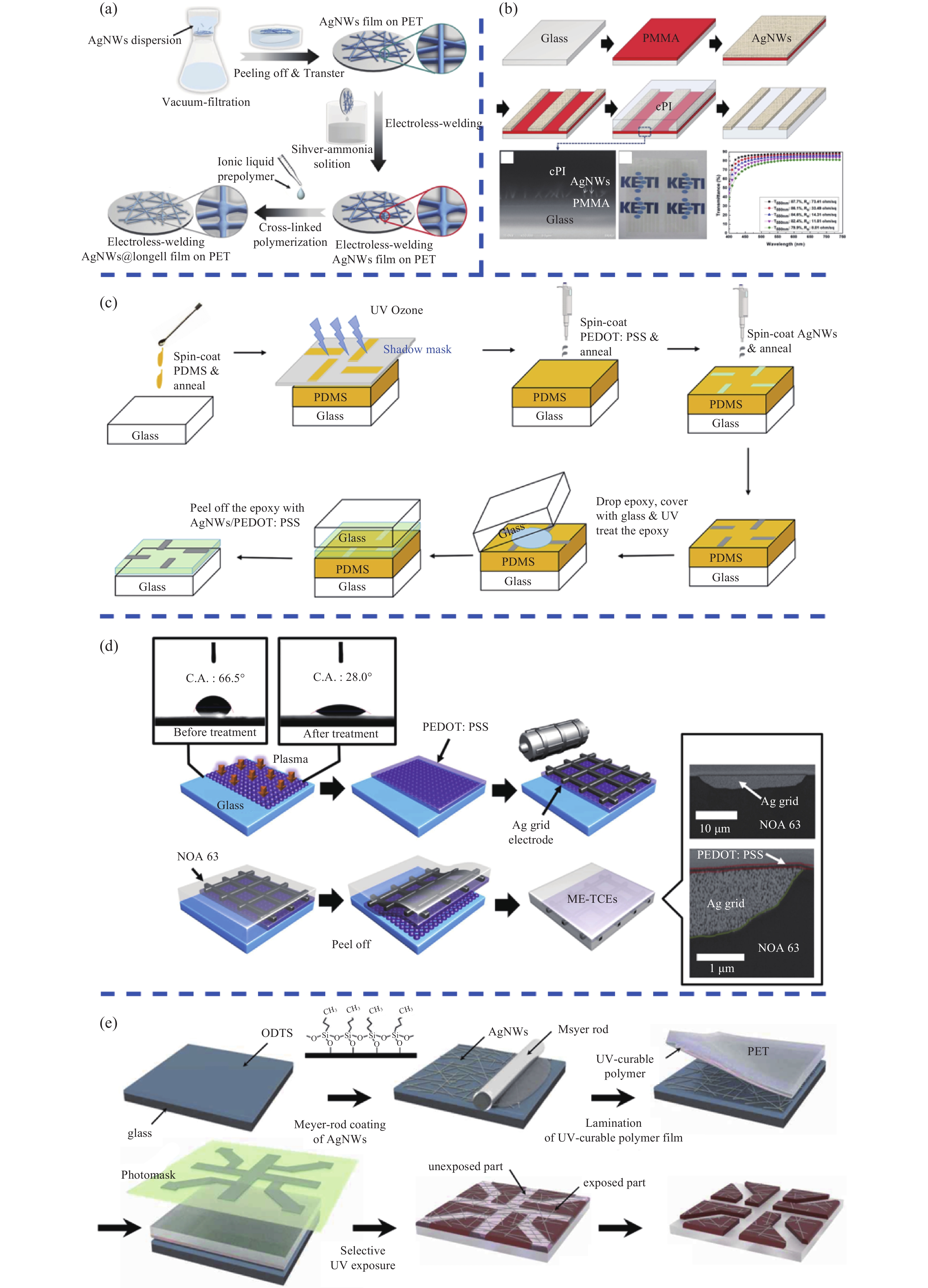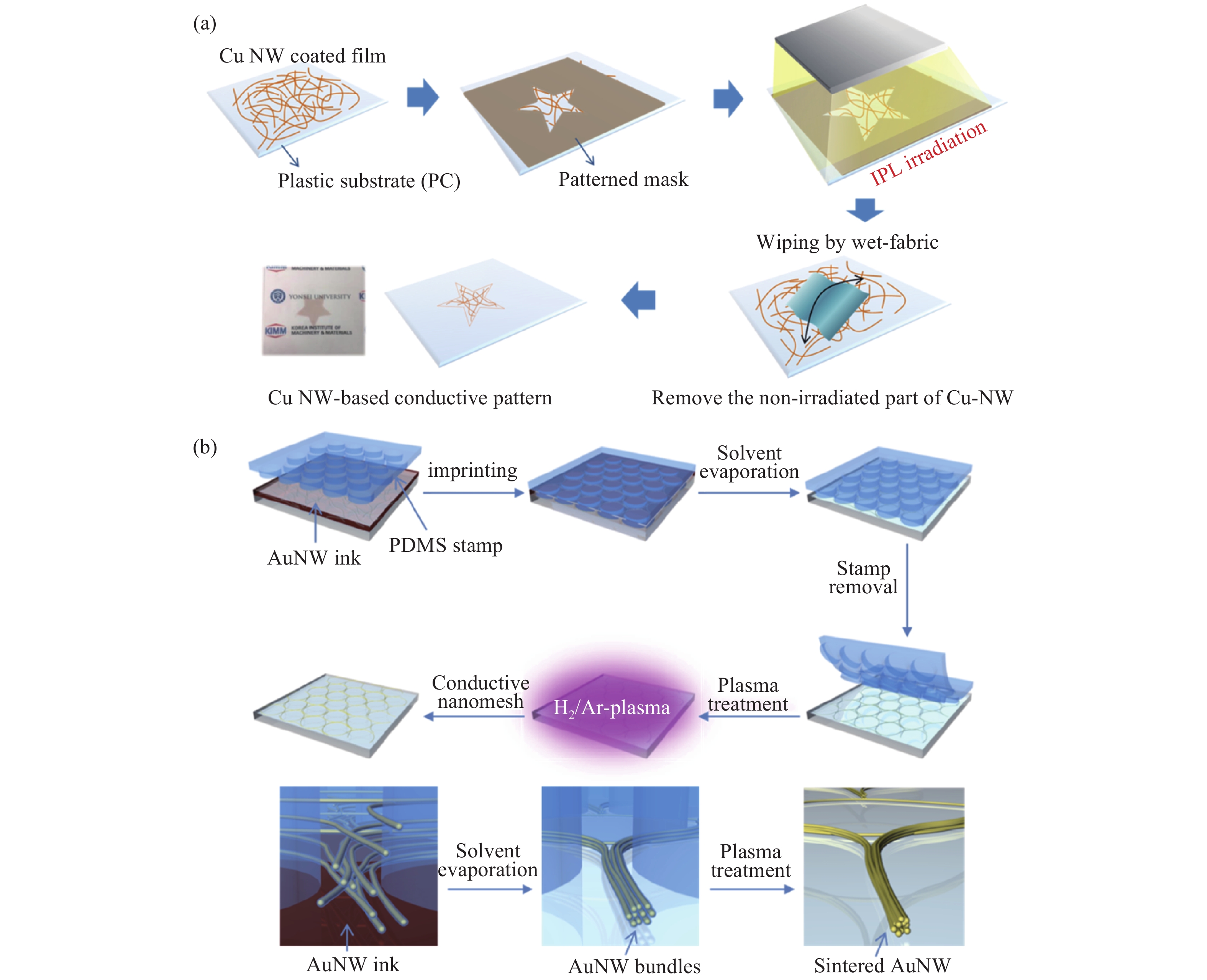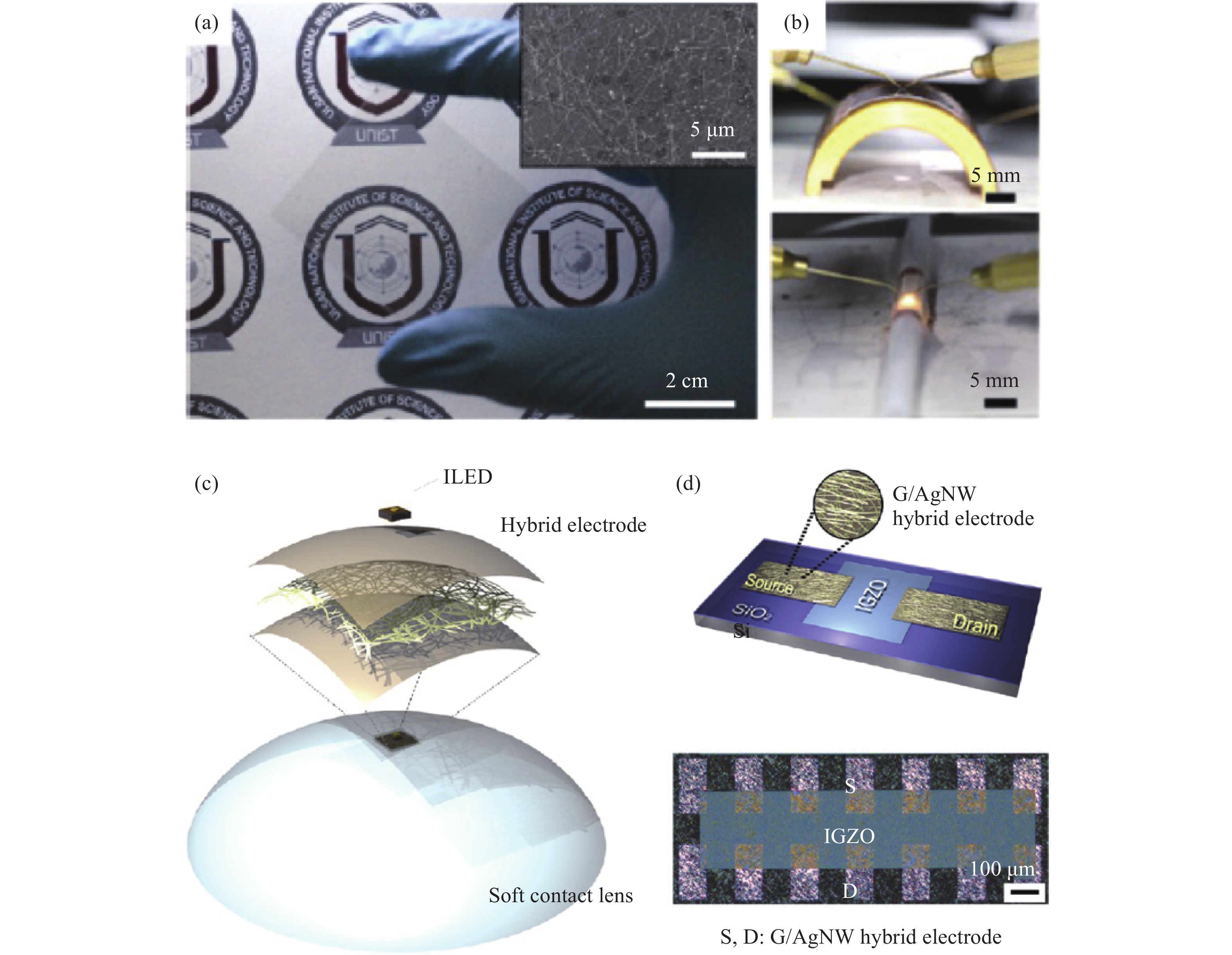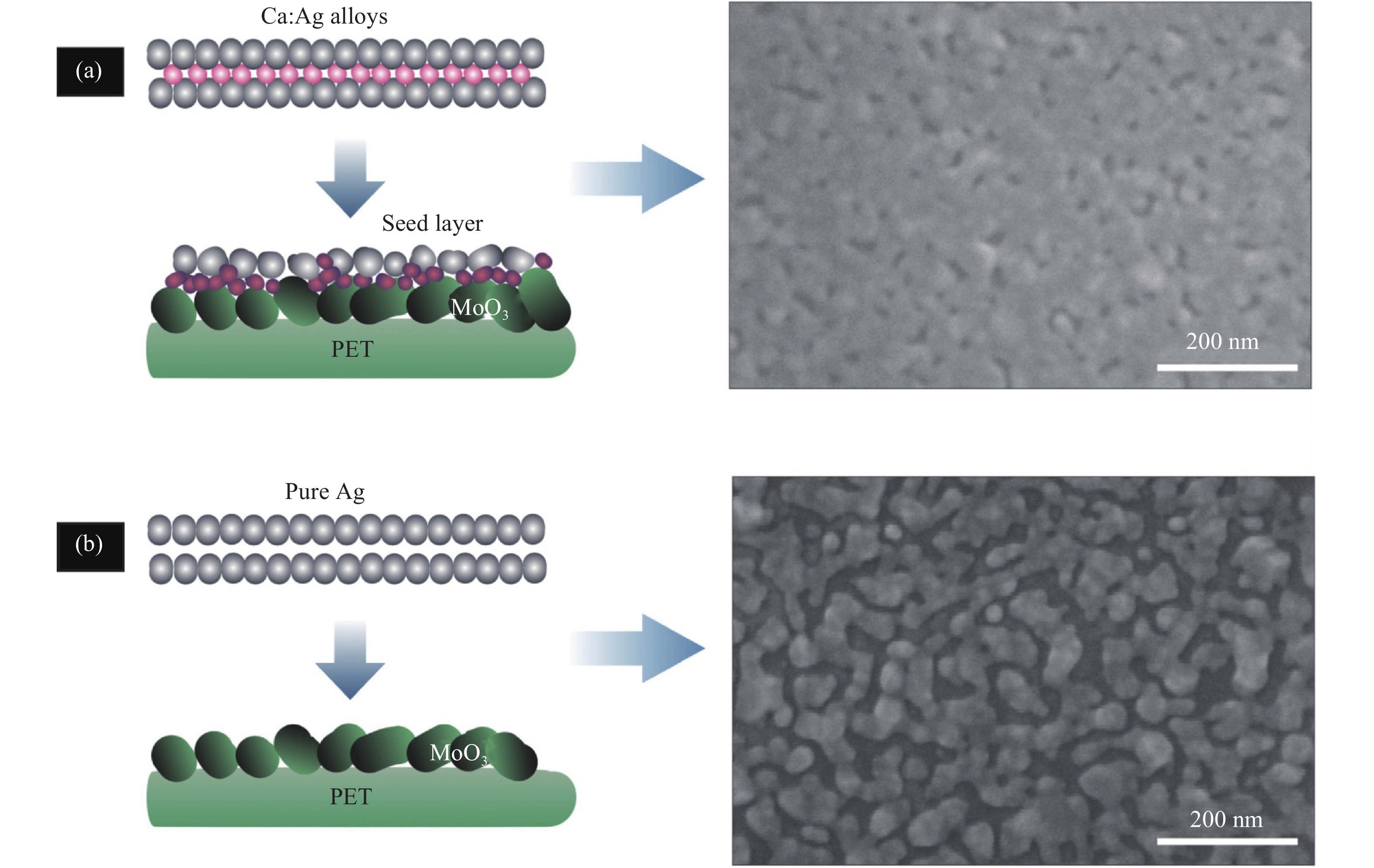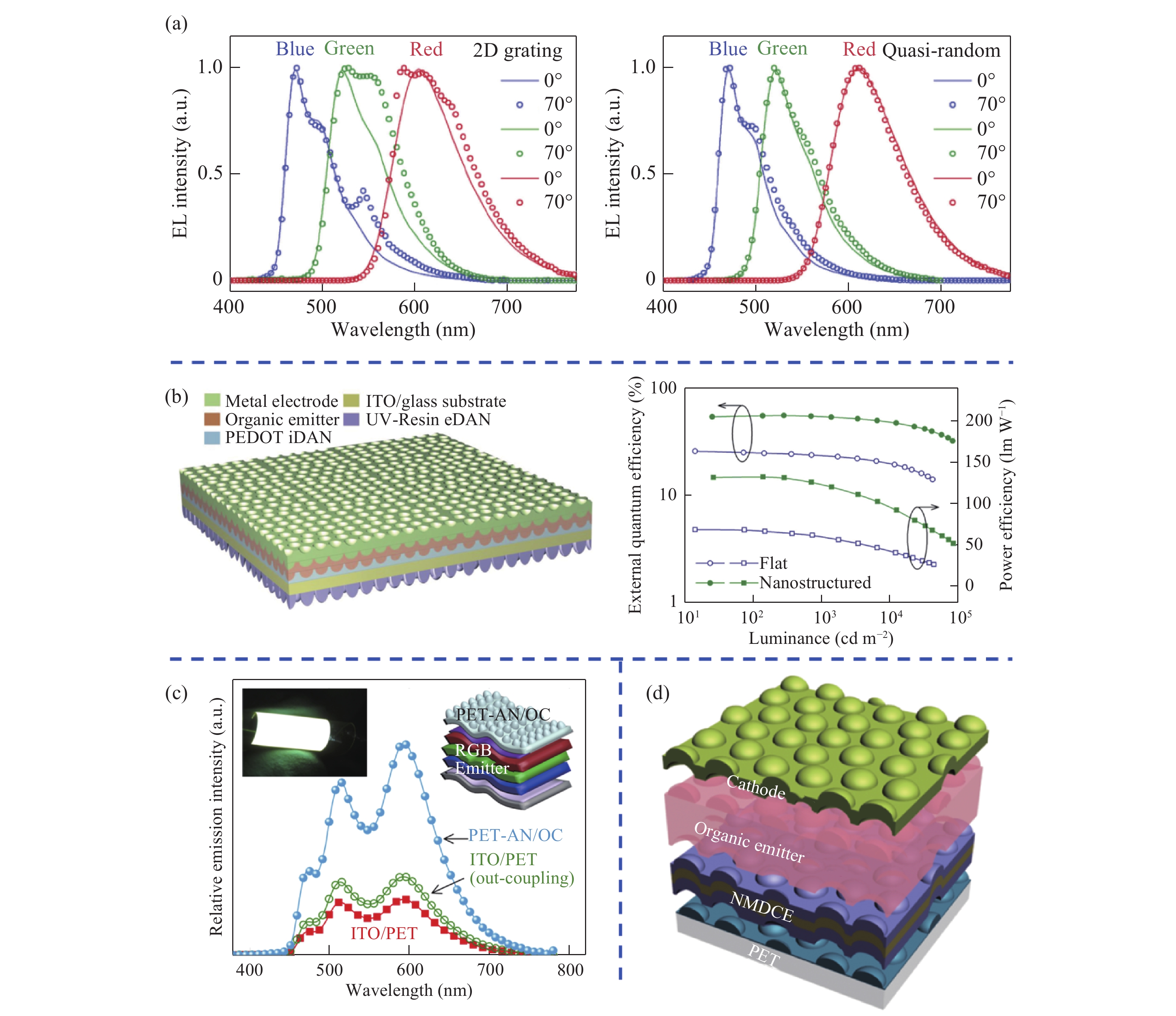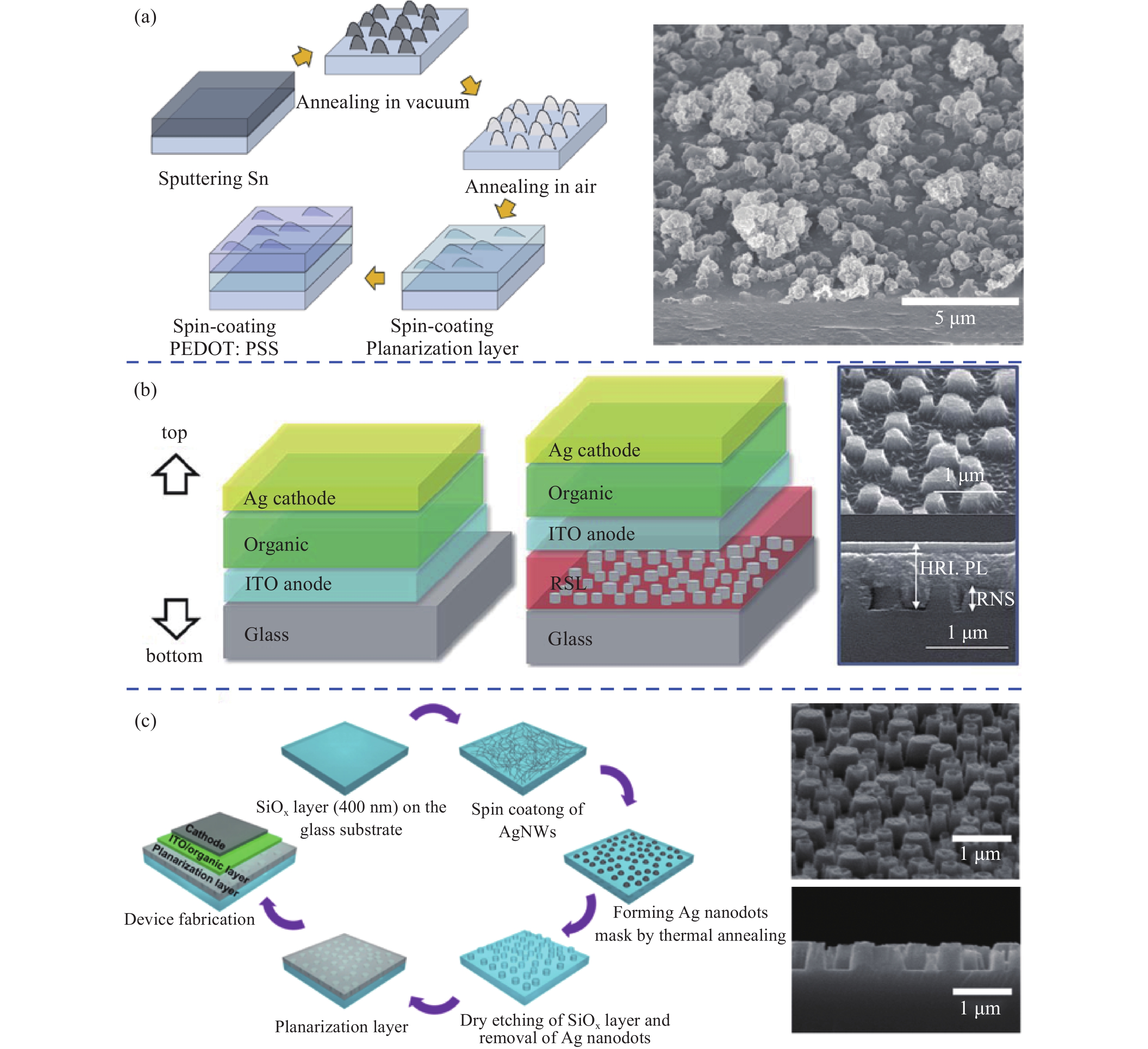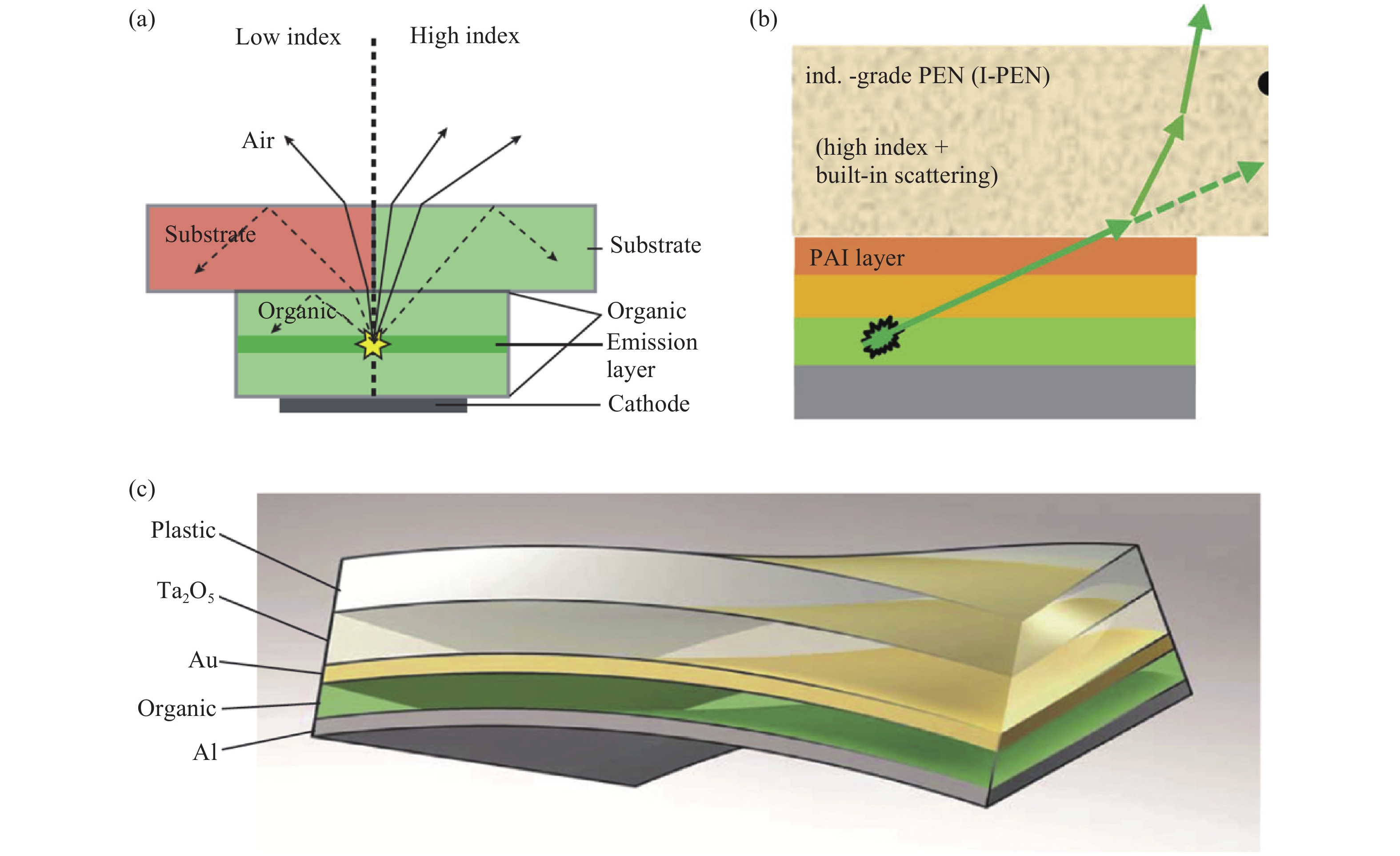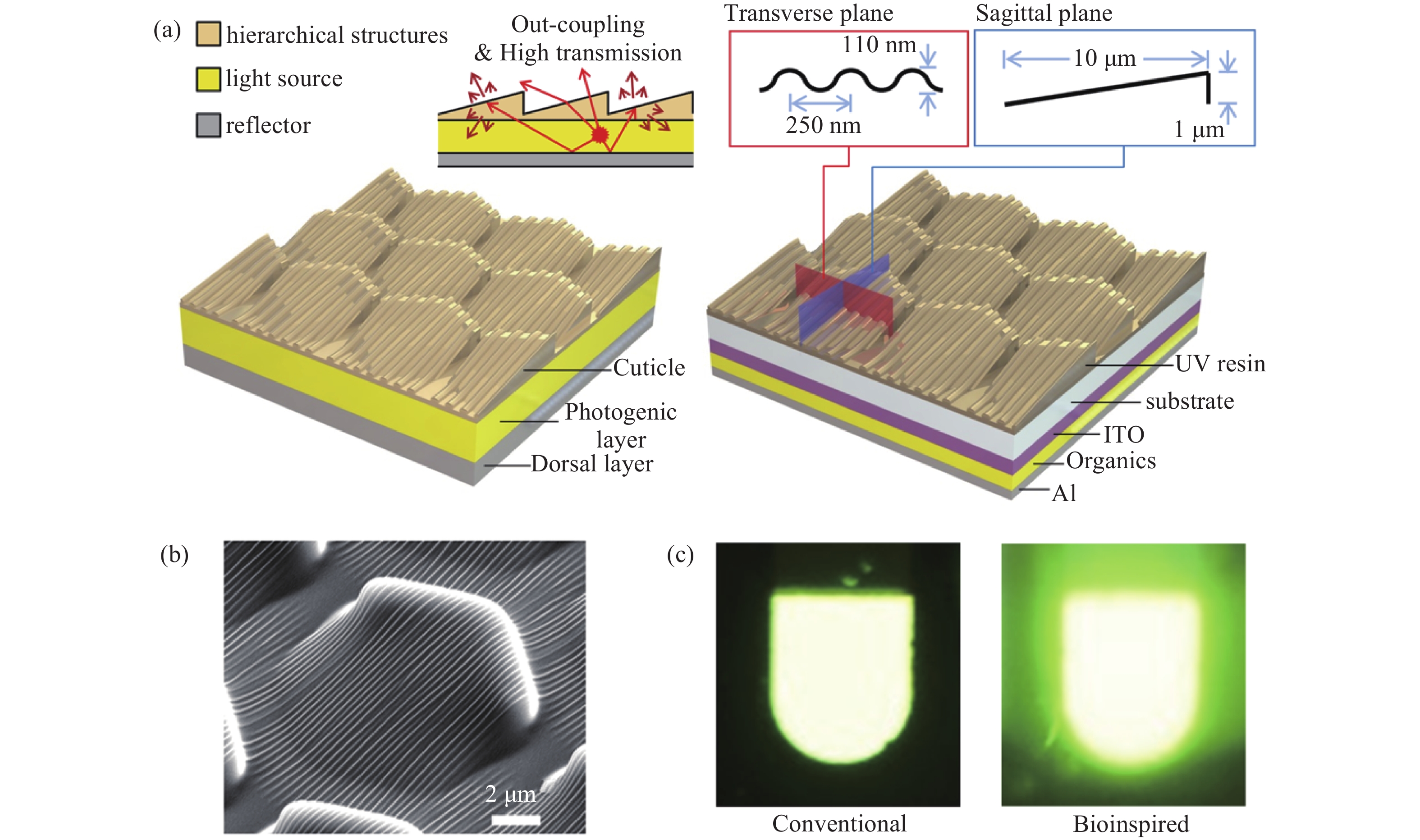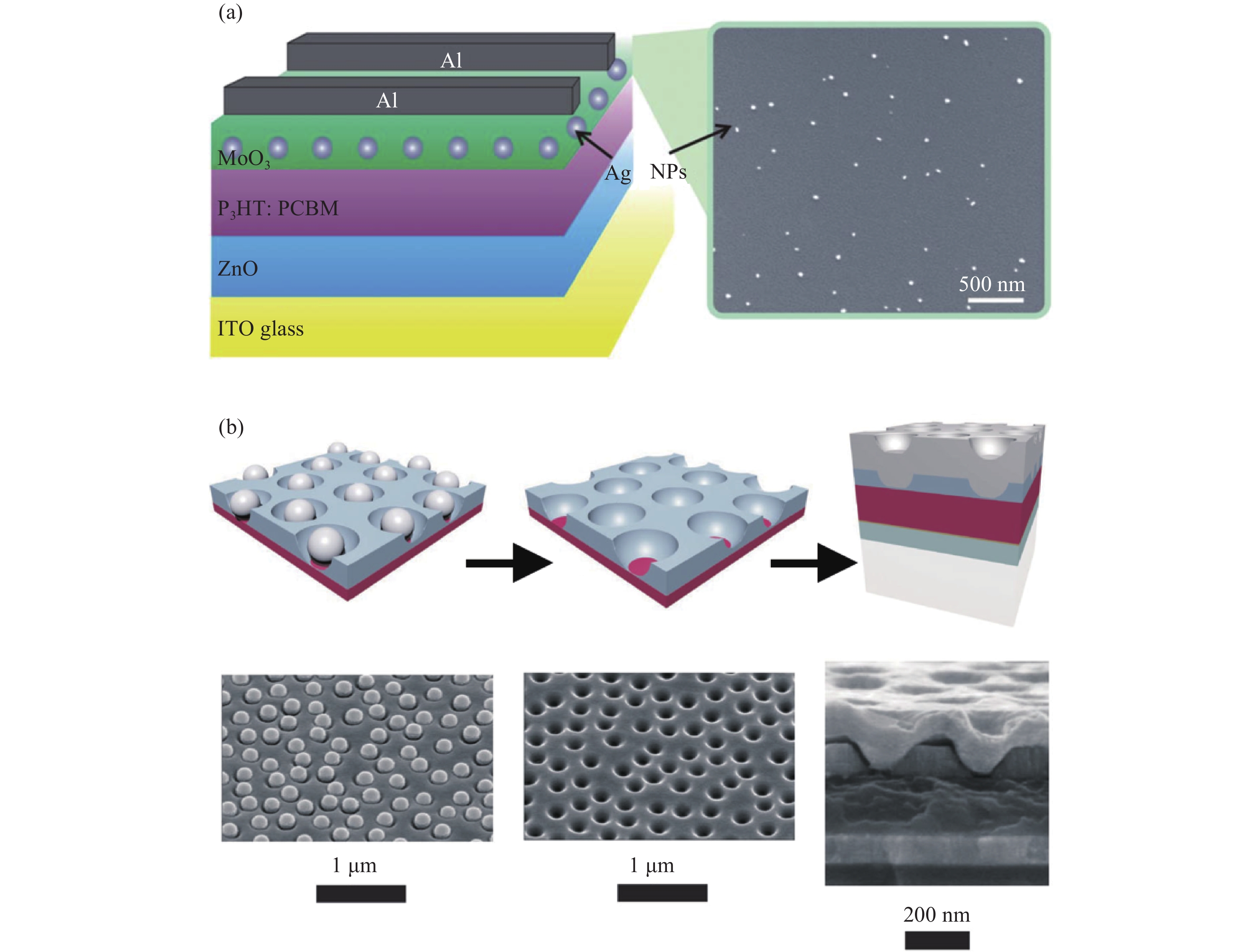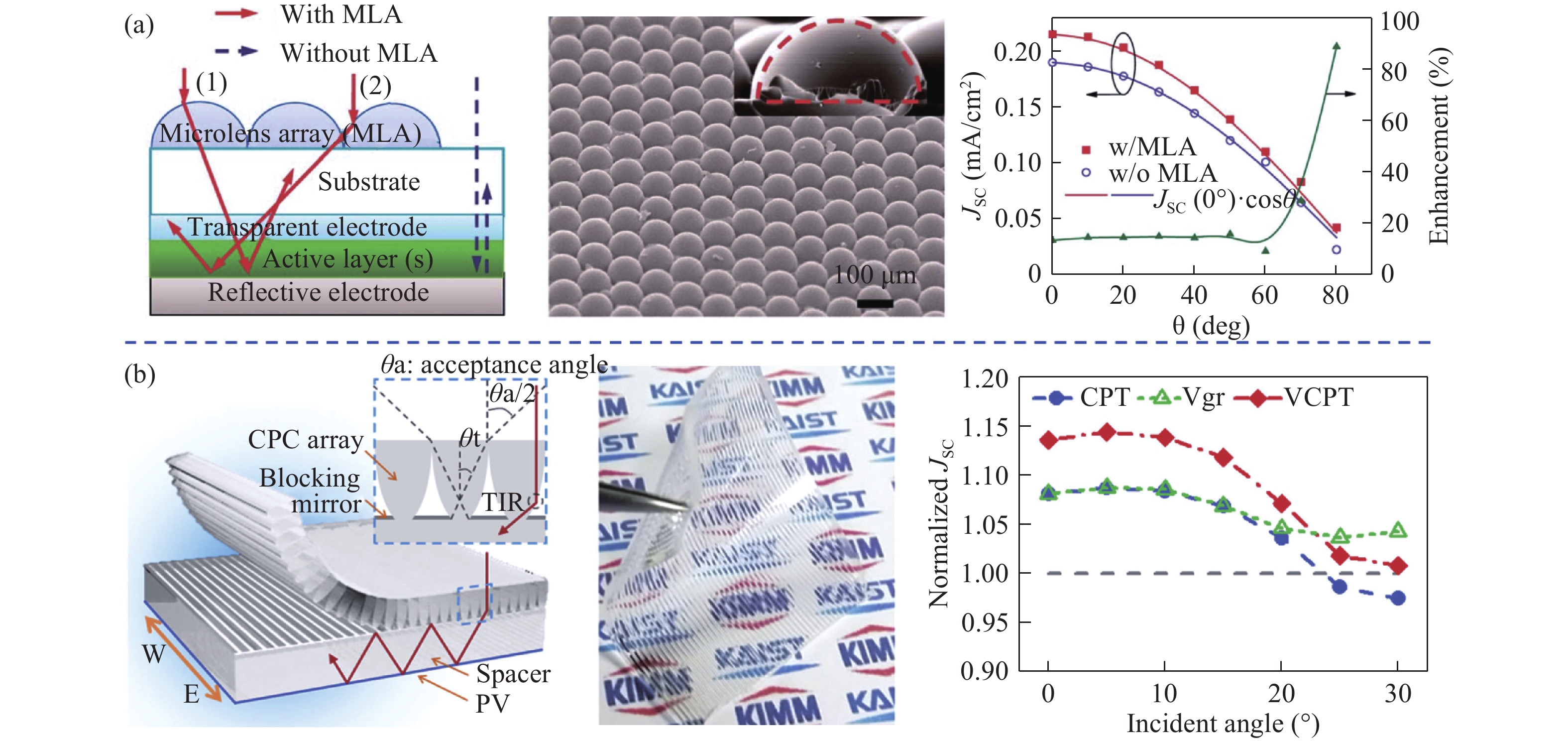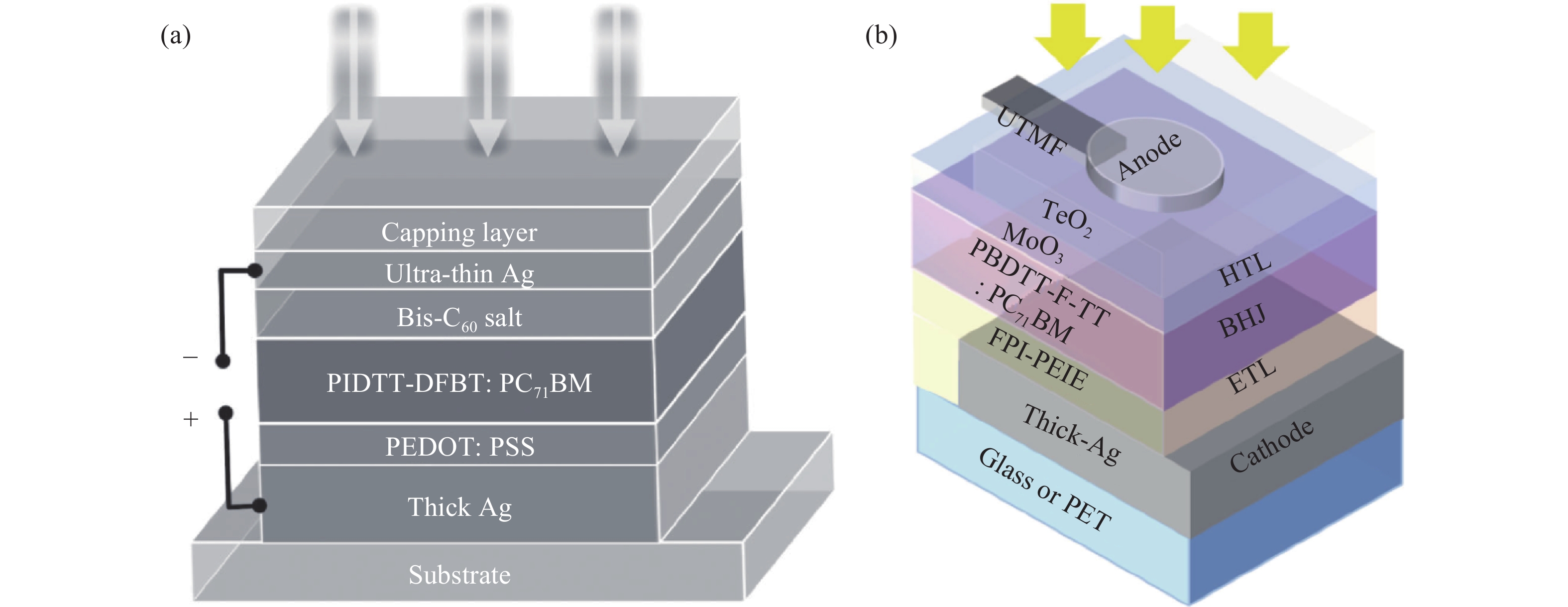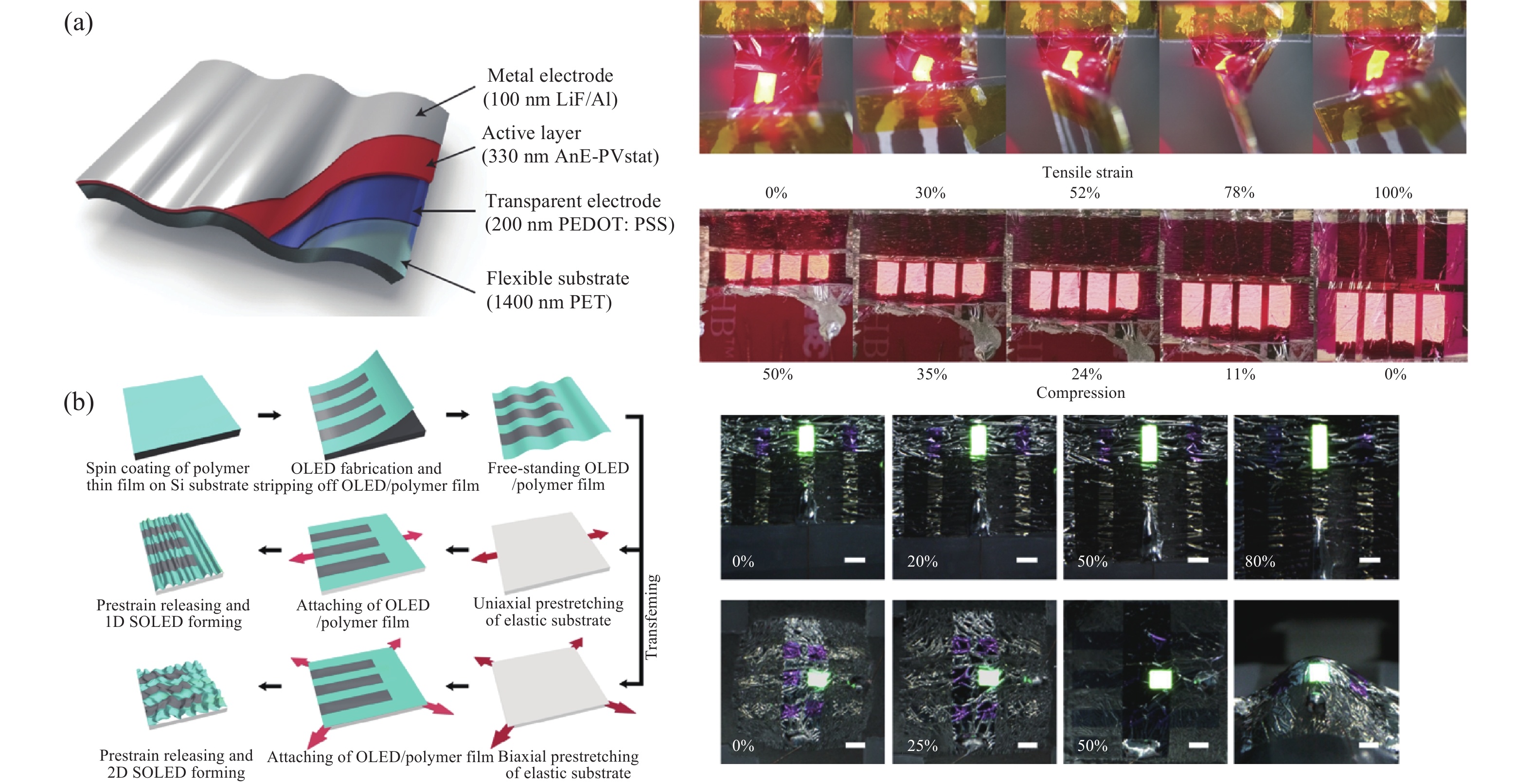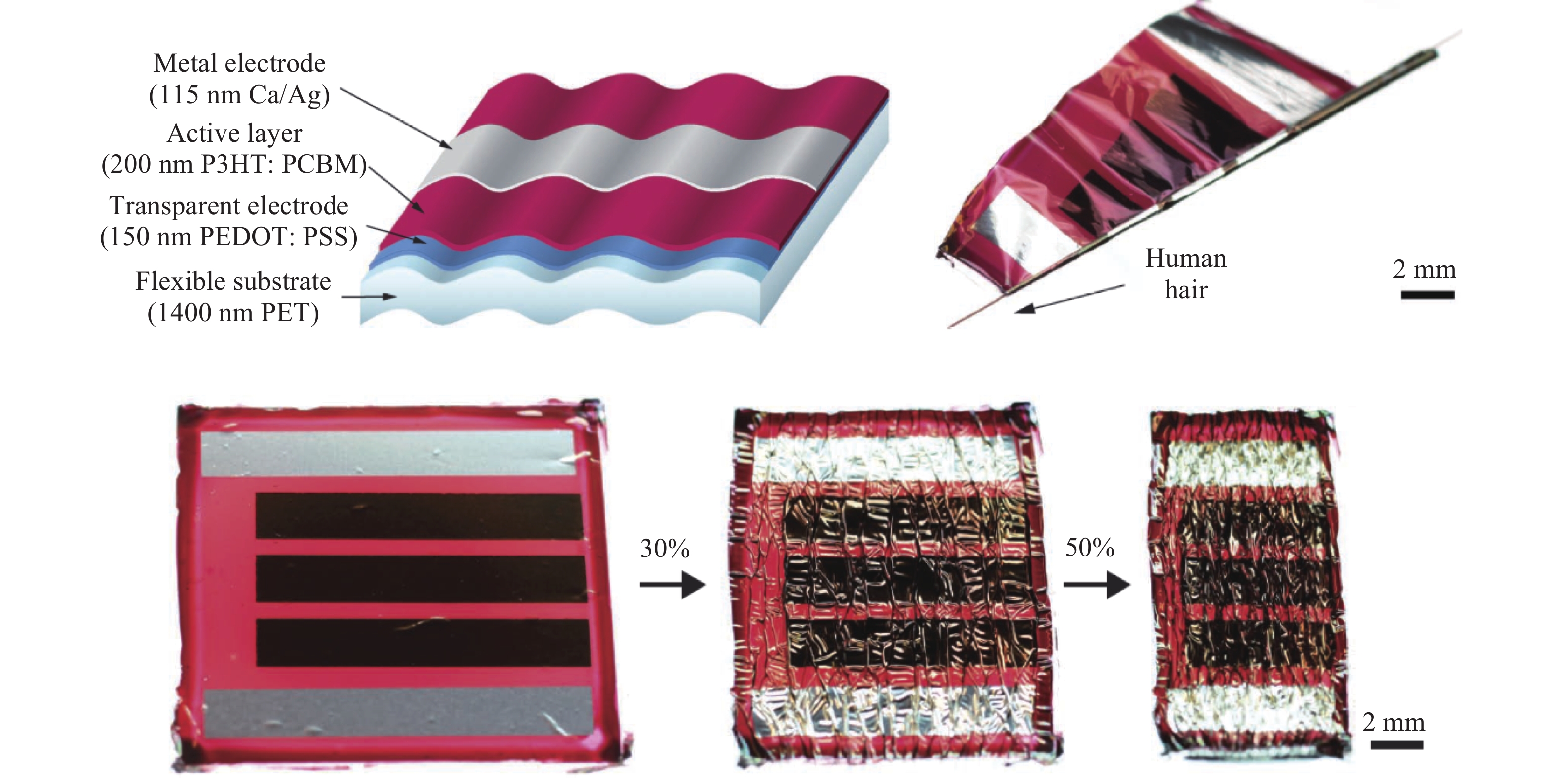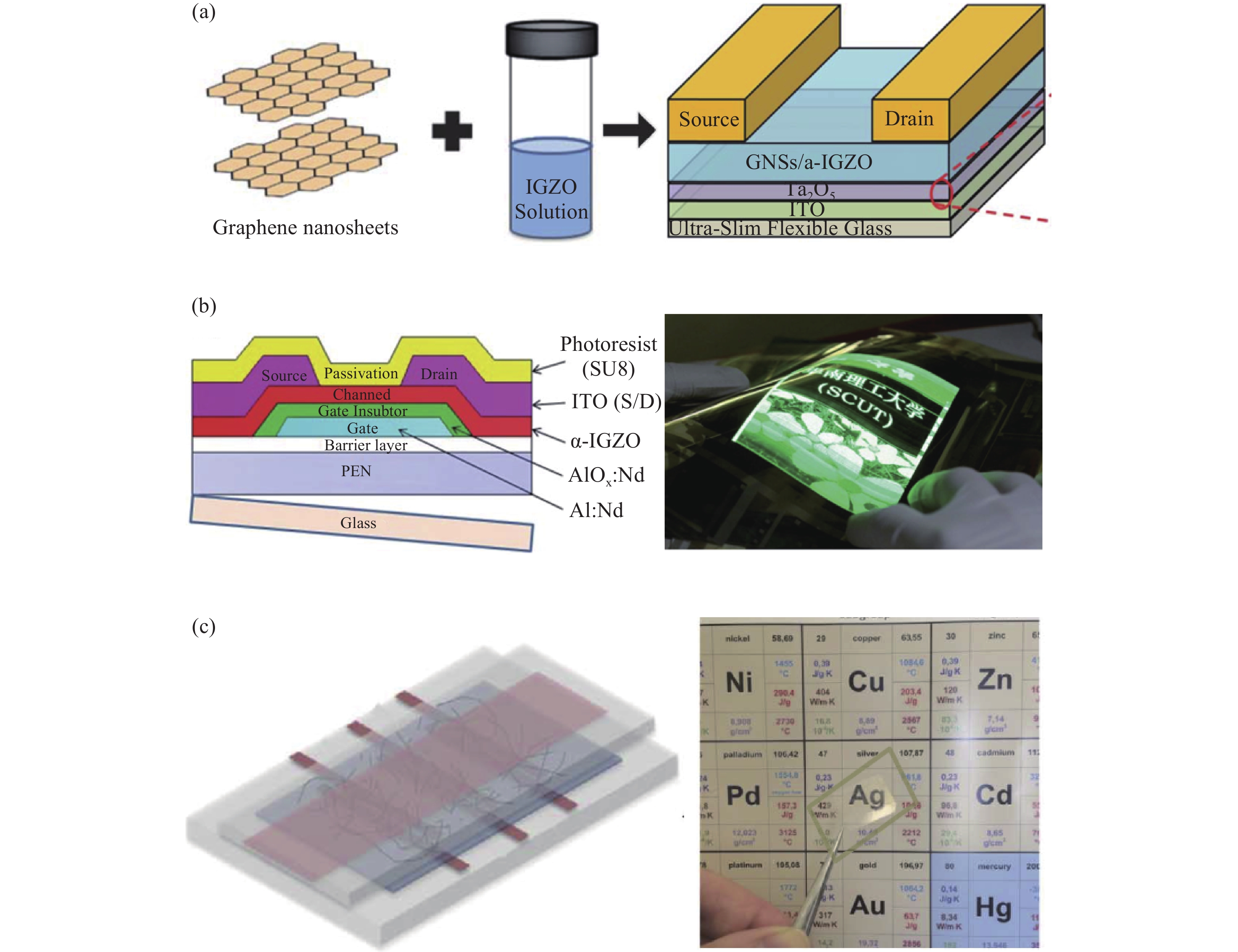| Citation: |
Hong Zhu, Yang Shen, Yanqing Li, Jianxin Tang. Recent advances in flexible and wearable organic optoelectronic devices[J]. Journal of Semiconductors, 2018, 39(1): 011011. doi: 10.1088/1674-4926/39/1/011011
****
H Zhu, Y Shen, Y Q Li, J X Tang, Recent advances in flexible and wearable organic optoelectronic devices[J]. J. Semicond., 2018, 39(1): 011011. doi: 10.1088/1674-4926/39/1/011011.
|
Recent advances in flexible and wearable organic optoelectronic devices
DOI: 10.1088/1674-4926/39/1/011011
More Information
-
Abstract
Flexible and wearable optoelectronic devices have been developing to a new stage due to their unique capacity for the possibility of a variety of wearable intelligent electronics, including bendable smartphones, foldable touch screens and antennas, paper-like displays, and curved and flexible solid-state lighting devices. Before extensive commercial applications, some issues still have to be solved for flexible and wearable optoelectronic devices. In this regard, this review concludes the newly emerging flexible substrate materials, transparent conductive electrodes, device architectures and light manipulation methods. Examples of these components applied for various kinds of devices are also summarized. Finally, perspectives about the bright future of flexible and wearable electronic devices are proposed. -
References
[1] Zhou L, Xiang H Y, Shen S, et al. High-performance flexible organic light-emitting diodes using embedded silver network transparent electrode. ACS Nano, 2014, 8(12): 12796 doi: 10.1021/nn506034g[2] Yin D, Feng J, Ma R, et al. Efficient and mechanically robust stretchable organic light-emitting devices by a laser-programmable buckling process. Nat Commun, 2016, 7: 11573 doi: 10.1038/ncomms11573[3] Lee J, Han T H, Park M H, et al. Synergetic electrode architecture for efficient graphene-based flexible organic light-emitting diodes. Nat Commun, 2016, 7: 11791 doi: 10.1038/ncomms11791[4] Ok K H, Kim J, Park S R, et al. Ultra-thin and smooth transparent electrode for flexible and leakage-free organic light-emitting diodes. Sci Rep, 2015, 5: 9464 doi: 10.1038/srep09464[5] White M S, Kaltenbrunner M, Glowacki E D, et al. Ultrathin, highly flexible and stretchable PLEDs. Nat Photonics, 2013, 7: 811 doi: 10.1038/nphoton.2013.188[6] Guo F M, Cui X, Wang K L, et al. Stretchable and compressible strain sensors based on carbon nanotube meshes. Nanoscale, 2016, 8: 19352 doi: 10.1039/C6NR06804A[7] Li Y W, Meng L, Yang Y, et al. High-efficiency robust perovskite solar cells on ultrathin flexible substrates. Nat Commun, 2016, 7: 10214 doi: 10.1038/ncomms10214[8] Lin Q F, Huang H T, Jing Y, et al. Flexible photovoltaic technologies. J Mater Chem C, 2014, 2: 1233 doi: 10.1039/c3tc32197e[9] Shin S S, Yang W S, Noh J H, et al. High-performance flexible perovskite solar cells exploiting Zn2SnO4 prepared in solution below 100 °C. Nat Commun, 2015, 6: 7410 doi: 10.1038/ncomms8410[10] Kim T, Kim J H, Kang T E, et al. Flexible, highly efficient all-polymer solar cells. Nat Commun, 2015, 6: 8547 doi: 10.1038/ncomms9547[11] Liang J J, Li L , Chen D, et al. Intrinsically stretchable and transparent thin-film transistors based on printable silver nanowires, carbon nanotubes and an elastomeric dielectric. Nat Commun, 2015, 6: 7647 doi: 10.1038/ncomms8647[12] Yeo W H, Kim Y S, Lee J, et al. Multifunctional epidermal electronics printed directly onto the skin. Adv Mater, 2013, 25: 2773 doi: 10.1002/adma.201204426[13] Roh E, Hwang B U, Kim D, et al. Stretchable, transparent, ultrasensitive, and patchable strain sensor for human-machine interfaces comprising a nanohybrid of carbon nanotubes and conductive elastomers. ACS Nano, 2015, 9(6): 6252 doi: 10.1021/acsnano.5b01613[14] Yamada T, Hayamizu Y, Yamamoto Y, et al. A stretchable carbon nanotube strain sensor for human-motion detection. Nat Nanotechnol, 2011, 6: 296 doi: 10.1038/nnano.2011.36[15] Son D, Lee J, Qiao S T, et al. Multifunctional wearable devices for diagnosis and therapy of movement disorders. Nat Nanotechnol, 2014, 9: 397 doi: 10.1038/nnano.2014.38[16] Wang X W, Gu Y, Xiong Z P, et al. Silk-molded flexible, ultrasensitive, and highly stable electronic skin for monitoring human physiological signals. Adv Mater, 2014, 26: 1336 doi: 10.1002/adma.201304248[17] ChadWebb R, Bonifas A P, Behnaz A, et al. Ultrathin conformal devices for precise and continuous thermal characterization of human skin. Nat Mater, 2013, 12: 938 doi: 10.1038/nmat3755[18] Ferrand H L, Bolisetty S, Demirors A F, et al. Magnetic assembly of transparent and conducting graphene-based fuctional composites. Nat Commun, 2016, 7: 12078 doi: 10.1038/ncomms12078[19] Han T H, Lee Y B, Choi M R, et al. Extremely efficient flexible organic light-emitting diodes with modified graphene anode. Nat Photonics, 2012, 6: 105 doi: 10.1038/nphoton.2011.318[20] Jia S, Sun H D, Du J H, et al. Graphene oxide/graphene vertical heterostructure electrodes for highly efficient and flexible organic light emitting diodes. Nanoscale, 2016, 8: 10714 doi: 10.1039/C6NR01649A[21] Hu L B, Kim H S, Lee J Y, et al. Scalable coating and properties of transparent, flexible, silver nanowire electrodes. ACS Nano, 2010, 4(5): 2955 doi: 10.1021/nn1005232[22] Hwang C, An J, Choi B D, et al. Controlled aqueous synthesis of ultra-long copper nanowires for stretchable transparent conducting electrode. J Phys Chem C, 2016, 4: 1441 doi: 10.1039/C5TC03614C[23] Kang H, Kang I, Han J, et al. Flexible and mechanically robust organic light-emitting diodes based on photopatternable silver nanowire electrodes. J Phys Chem C, 2016, 120: 22012 doi: 10.1021/acs.jpcc.6b06599[24] Maurer J H M, González-García L, Reiser B, et al. Templated self-assembly of ultrathin gold nanowires by nanoimprinting for transparent flexible electronics. Nano Lett, 2016, 16: 2921 doi: 10.1021/acs.nanolett.5b04319[25] Kim H J, Song M, Jeong J H, et al. Highly efficient and stable cupronickel nanomesh electrode for flexible organic photovoltaic devices. J Power Sources, 2016, 331: 22 doi: 10.1016/j.jpowsour.2016.09.024[26] Cheng T, Zhang Y Z, Lai W Y, et al. Stretchable thin-film electrodes for flexible electronics with high deformability and stretchability. Adv Mater, 2015, 27: 3349 doi: 10.1002/adma.201405864[27] Han B, Pei K, Huang Y L, et al. Uniform self-forming metallic network as a high-performance transparent conductive electrode. Adv Mater, 2014, 26: 873 doi: 10.1002/adma.v26.6[28] Jeong D W, Jang N S, Kim K H, et al. A stretchable sensor platform based on simple and scalable lift-off micropatterning of metal nanowire network. RSC Adv, 2016, 6: 74418 doi: 10.1039/C6RA15385B[29] Lee J Y, Connor S T, Cui Y, et al. Solution-processed metal nanowire mesh transparent electrodes. Nano Lett, 2008, 8(2): 689 doi: 10.1021/nl073296g[30] Cho H, Yun C H, Park J W, et al. Highly flexible organic light-emitting diodes based on ZnS/Ag/WO3 multilayer transparent electrodes. Org Electron, 2009, 10: 1163 doi: 10.1016/j.orgel.2009.06.004[31] Kim D Y, Han Y C, Kim H C, et al. Highly transparent and flexible organic light-emitting diodes with structure optimized for anode/cathode multilayer electrodes. Adv Funct Mater, 2015, 25(46): 7145 doi: 10.1002/adfm.201502542[32] Xiang H Y, Li Y Q, Zhou L, et al. Outcoupling-enhanced flexible organic light-emitting diodes on ameliorated plastic substrate with built-in indium-tin-oxide-free transparent electrode. ACS Nano, 2015, 9(7): 7553 doi: 10.1021/acsnano.5b02826[33] Ou Q D, Zhou L, Li Y Q, et al. Simultaneously enhancing color spatial uniformity and operational stability with deterministic quasi-periodic nanocone arrays for tandem organic light-emitting diodes. Advd Opt Mater, 2015, 3: 87 doi: 10.1002/adom.v3.1[34] Xu L H, Ou Q D, Li Y Q, et al. Microcavity-free broadband light outcoupling enhancement in flexible organic light-emitting diodes with nanostructured transparent metal-dielectric composite electrodes. ACS Nano, 2016, 10: 1625 doi: 10.1021/acsnano.5b07302[35] Kim J J, Lee J, Yang S P, et al. Biologically inspired organic light-emitting diodes. Nano Lett, 2016, 16: 2994 doi: 10.1021/acs.nanolett.5b05183[36] Huh J W, Shin J W, Cho D H, et al. A randomly nano-structured scattering layer for transparent organic light emitting diodes. Nanoscale, 2014, 6: 10727 doi: 10.1039/C4NR01520G[37] Lee K, Shin J W, Park J H, et al. A light scattering layer for internal light extraction of organic light-emitting diodes based on silver nanowires. ACS Appl Mater Interfaces, 2016, 8: 17409 doi: 10.1021/acsami.6b02924[38] Oh M C, Park J H, Jeon H J, et al. Hollow-core polymeric nanoparticles for the enhancement of OLED outcoupling efficiency. Dispalys, 2015, 37: 72 doi: 10.1016/j.displa.2014.11.004[39] Mann V, Rastogi V. Dielectric nanoparticles for the enhancement of OLED light extraction efficiency. Opt Commun, 2017, 387: 202 doi: 10.1016/j.optcom.2016.11.059[40] Cheng P P, Ma G F, Li J, et al. Plasmonic backscattering enhancement for inverted polymer solar cells. J Mater Chem, 2012, 22: 22781 doi: 10.1039/c2jm34856j[41] Chen K S, Yip H L, Salinas J F, et al. Strong photocurrent enhancements in highly efficient flexible organic solar cells by adopting a microcavity configuration. Adv Mater, 2014, 26(20): 3349 doi: 10.1002/adma.v26.20[42] Tsujimura T, Fukawa J, Endoh K, et al. Development of flexible organic light-emitting diode on barrier film and roll-to-roll manufacturing. J Soc Inform Display, 2014, 22(8): 412 doi: 10.1002/jsid.261[43] Yao Y G, Tao J S, Zou J H, et al. Light management in plastic-paper hybrid substrate towards high-performance optoelectronics. Energy Environm Sci, 2016, 9: 2278 doi: 10.1039/C6EE01011C[44] Hsieh Y C, Yano H, Nogi M, et al. An estimation of the Young’s modulus of bacterial cellulose filaments. Cellulose, 2008, 15: 507 doi: 10.1007/s10570-008-9206-8[45] Czaja W, Romanovicz D, Brown R M Jr. Structural investigations of microbial cellulose produced in stationary and agitated culture. Cellulose, 2004, 11: 403 doi: 10.1023/B:CELL.0000046412.11983.61[46] Nakagaito A H, Yano H. Novel high-strength biocomposite based on microfibrillated cellulose having nano-order-unit web-like network structure. Appl Phys A, 2005, 80: 155 doi: 10.1007/s00339-003-2225-2[47] Ummartyotin S, Juntaro J, Sain M, et al. Development of transparent bacterial cellulose nanocomposite film as substrate for flexible organic light emitting diode (OLED) display. Industr Crops Prod, 2012, 35: 92 doi: 10.1016/j.indcrop.2011.06.025[48] Okahisa Y, Yoshida A, Miyaguchi S, et al. Optical transparent wood-cellulose nanocomposite as a base substrate for flexible organic light-emitting diode displays. Compos Sci Technol, 2009, 69: 1958 doi: 10.1016/j.compscitech.2009.04.017[49] Ji S Y, Hyun B G, Kim K, et al. Photo-patternable and transparent films using cellulos nanofibers for stretchable origami electronics. NPG Asia Mater, 2016, 8: e299 doi: 10.1038/am.2016.113[50] Zhou Y H, Khan T M, Liu J C, et al. Efficient recyclable organic solar cells on cellulose nanocrystal substrates with a conducting polymer top electrode deposited by film-transfer lamination. Org Electron, 2014, 15: 661 doi: 10.1016/j.orgel.2013.12.018[51] Jung Y H, Chang T H, Zhang H L, et al. High-performance green flexible electronics based on biodegradable cellulose nanofibril paper. Nat Commun, 2015, 6: 7170 doi: 10.1038/ncomms8170[52] Liu Y F, Feng J, Yin D, et al. Highly flexible and efficient top-emittingd organic light-emitting devices with ultrasmooth Ag anode. Opt Lett, 2012, 37(11): 1796 doi: 10.1364/OL.37.001796[53] Lee H, Yoo J K, Park J H, et al. A stretchable polymer-carbon nanotube composite electrode for flexible lithium-ion batteries: porosity engineering by controlled phase separation. Adv Energy Mater, 2012, 2(8): 976 doi: 10.1002/aenm.v2.8[54] Cao W R, Li J, Chen H Z, et al. Transparent electrodes for organic optoelectronic devices: a review. J Photonics Energy, 2014, 4(1): 040990 doi: 10.1117/1.JPE.4.040990[55] Lee H, Yoo J K, Park J H, et al. Transfer-printed PEDOT: PSS electrodes using mild acids for high conductivity and improved stability with application to flexible organic solar cells. ACS Appl Mater Interfaces, 2016, 8: 14029 doi: 10.1021/acsami.6b01389[56] Fallahzadeh A, Saghaei J, Saghaei T. Ultra-smoothpoly (3,4- ethylene dioxythiophene): poly (styrene sulfonate) films for flexible indium tin oxide- free organic light-emitting diodes. J Lumin, 2016, 169: 251 doi: 10.1016/j.jlumin.2015.09.021[57] Aleksandrova M, Kurtev N, Videkov V, et al. Material alternative to ITO for transparent conductive electrode in flexible display and photovoltaic devices. Microelectron Eng, 2015, 145: 112 doi: 10.1016/j.mee.2015.03.053[58] Hsu C T, Wu C, Chuang C N, et al. Synthesis and characterization of nano silver-modified graphene/PEDOT:PSS for highly conductive and transparent nanocomposite films. J Polym Res, 2015, 22: 200 doi: 10.1007/s10965-015-0847-7[59] Lee H J, Song Y S, An T K, et al. Ultrasmooth transparent conductive hybrid films of reduced graphene oxide and single-walled carbon nanotube by ultrasonic spraying. Synth Metals, 2016, 221: 340 doi: 10.1016/j.synthmet.2016.10.012[60] Liu Z K, You P, Xie C, et al. Ultrathin and flexible perovskite solar cells with graphene transparent electrodes. Nano Energy, 2016, 28: 151 doi: 10.1016/j.nanoen.2016.08.038[61] Huang J H, Fang J H, Liu C C, et al. Effective work function modulation of graphene/carbon nanotube composite films as transparent cathodes for organic optoelectronics. ACS Nano, 2011, 5(8): 6262 doi: 10.1021/nn201253w[62] Anuj R, Madaria A R, Akshay Kumar A, et al. Large scale, highly conductive and patterned transparent films of silver nanowires on arbitrary substrates and their application in touch screens. Nanotechnology, 2011, 22: 245201 doi: 10.1088/0957-4484/22/24/245201[63] Yang Y, Ding S, Arak T, et al. Facile fabrication of stretchable Ag nanowire/polyurethane electrodes using high intensity pulsed light. Nano Res, 2016, 9: 401 doi: 10.1007/s12274-015-0921-9[64] Altin Y, Tas M, Borazan I, et al. Solution-processed transparent conducting electrodes with graphene, silver nanowires and PEDOT: PSS as alternative to ITO. Surf Coat Technol, 2016, 302: 75 doi: 10.1016/j.surfcoat.2016.05.058[65] Lee M S, Lee K, Kim S Y, et al. High-performance, transparent, and stretchable electrodes using graphene-metal nanowire hybrid structures. Nano Lett, 2013, 13: 2814 doi: 10.1021/nl401070p[66] An B W, Hyun B G, Kim S Y, et al. Stretchable and transparent electrodes using structures of graphene-metal nanothrough networks with high performances and ultimate uniformity. Nano Lett, 2014, 14: 6322 doi: 10.1021/nl502755y[67] Chen J H, Jang C, Xiao S D, et al. Intrinsic and extrinsic performance limits of graphene devices on SiO2. Nat Nanotechnol, 2008, 3: 206 doi: 10.1038/nnano.2008.58[68] Huang X, Zeng Z Y, Fan Z X, et al. Graphene-based electrodes. Adv Mater, 2012, 24: 5979 doi: 10.1002/adma.201201587[69] Lee C G, Wei X D, Kysar J W, et al. Measurement of the elastic properties and intrinsic strength of monolayer graphene. Science, 2008, 321: 385 doi: 10.1126/science.1157996[70] Stankovich S S, Dikin D A, Dommett G H B, et al. Graphene-based composite materials. Nature, 2006, 442: 282 doi: 10.1038/nature04969[71] Sun T, Wang Z L, Shi Z J, et al. Multilayered graphene used as anode of organic light emitting devices. Appl Phys Lett, 2010, 96: 133301 doi: 10.1063/1.3373855[72] Wu J B, Agrawal M, Becerril H A, et al. Organic light-emitting diodes on solution-processed graphene transparent electrodes. ACS Nano, 2010, 4(1): 43 doi: 10.1021/nn900728d[73] Li N, Oida S, Tulevski G S, et al. Efficient and bright organic light-emitting diodes on single-layer graphene electrodes. Nat Commun, 2013, 4: 2294 doi: 10.1038/ncomms3294[74] Song M, Dae You D S, Lim K, et al. Highly efficient and bendable organic solar cells with solution-processed silver nanowire electrodes. Adv Funct Mater, 2013, 23: 4177 doi: 10.1002/adfm.v23.34[75] Madaria A R, Kumar A, Ishikawa F N, et al. Uniform, highly conductive, and patterned transparent films of a percolating silver nanowire network on rigid and flexible substrates using a dry transfer technique. Nano Res, 2010, 3: 564 doi: 10.1007/s12274-010-0017-5[76] Kim J, Nam Y S, Song M H, et al. Large pulsed electron beam welded percolation networks of silver nanowires for transparent and flexible electrodes. ACS Appl Mater Interfaces, 2016, 8: 20938 doi: 10.1021/acsami.6b05874[77] Wei B W, Wu X K, Lian L, et al. A highly conductive and smooth AgNW/PEDOT: PSS film treated by hot-pressing as electrode for organic light emitting diode. Org Electron, 2017, 43: 182 doi: 10.1016/j.orgel.2017.01.030[78] Xiong X X, Liu H L, Chen Y Z, et al. Highly conductive, air-stable silver nanowire@ iongel composite films toward flexible transparent electrodes. Adv Mater, 2016, 28: 7167 doi: 10.1002/adma.201600358[79] Yun H J, Kim S J, Hwang J H, et al. Silver nanowire- IZO- conducting polymer hybrids for flexible and transparent conductive electrodes for organic light-emitting diodes. Sci Rep, 2016, 6: 34150 doi: 10.1038/srep34150[80] Kim D H, Ko E H, Kim K H, et al. Transparent and flexible Ag nanowire network covered by a thin ITO layer for flexible organic light emitting diodes. ECS J Solid State Technol, 2016, 5(7): 124 doi: 10.1149/2.0221607jss[81] Triambulo R E, Cheong H G, Park J W. All-solution-processed foldable transparent electrodes of Ag nanowire mesh and metal matrix films for flexible electronics. Org Electron, 2014, 15: 2685 doi: 10.1016/j.orgel.2014.07.039[82] Lin X Z, Chen S M, Yu J N, et al. Enhanced conductivity of transparent and flexible silver nanowire electrodes fabricated by a solution-processed method at room temperature. Thin Solid Films, 2017, 624: 54 doi: 10.1016/j.tsf.2017.01.027[83] Tao Y, Li J, Li K, et al. Inkjet-printed Ag grid combined with Ag nanowires to form a transparent hybrid electrode for organic electronics. Org Electron, 2017, 41: 179 doi: 10.1016/j.orgel.2016.10.046[84] Chiang K M, Huang Z Y, Tsai W L, et al. Orthogonally weaved silver nanowire networks for very efficient organic optoelectronic devices. Org Electron, 2017, 43: 15 doi: 10.1016/j.orgel.2016.12.054[85] Duan Y H, Duan Y, Wang W, et al. Highly flexible peeled-off silver nanowire transparent anode using in organic light-emitting devices. Appl Surf Sci, 2015, 351: 445 doi: 10.1016/j.apsusc.2015.05.161[86] Liu Y S, Feng J, Ou X L, et al. Ultrasmooth, highly conductive and transparent PEDOT:PSS/silver nanowire composite electrode for flexible organic light-emitting devices. Org Electron, 2016, 31: 247 doi: 10.1016/j.orgel.2016.01.014[87] Liu S Y, Ho S H, So F. Novel patterning method for silver nanowire electrodes for thermal-evaporated organic light emitting diodes. ACS Appl Mater Interfaces, 2016, 8: 9268 doi: 10.1021/acsami.6b00719[88] Jin W Y, Ginting R T, Ko K J, et al. Ultra-smooth, fully solution-processed large-area transparent conducting electrodes for organic devices. Sci Rep, 2016, 6: 36475[89] Wang R L, Ruan H B. Synthesis of copper nanowires and its application to flexible transparent electrode. J Alloys Compd, 2016, 656: 936 doi: 10.1016/j.jallcom.2015.09.279[90] Zhong Z Y, Lee H J, Kan D W, et al. Continuous patterning of copper nanowire-based transparent conducting electrodes for use in flexible electronic applications. ACS Nano, 2016, 10: 7847 doi: 10.1021/acsnano.6b03626[91] Won Y, Kim A, Lee D, et al. Annealing-free fabrication of highly oxidation-resistive copper nanowire composite conductors for photovoltaics. NPG Asia Mater, 2014, 6: e105 doi: 10.1038/am.2014.36[92] Gong S, Zhao Y M, Yap L W, et al. Fabrication of highly transparent and flexible nanomesh electrode via self-assembly of ultrathin gold nanowires. Adv Electron Mater, 2016, 1: 1600121 doi: 10.1002/aelm.201600121[93] Dong H, Wu Z X, Jiang Y Q, et al. A flexible and thin graphene/silver nanowires/polymer hybrid transparent electrode for optoelectronic devices. ACS Appl Mater Interfaces, 2016, 8: 31212 doi: 10.1021/acsami.6b09056[94] Chen R Y, Das S R, Jeong C, et al. Co-percolating graphene-wrapped silver nanowire network for high performance, highly stable, transparent conducting electrodes. Adv Funct Mater, 2013, 23: 5150 doi: 10.1002/adfm.v23.41[95] Pang H Q, Yuan Y B, Zhou Y F, et al. ZnS/Ag/ZnS coating as transparent anode for organic light emitting diodes. J Lumin, 2007, 122: 587[96] Yoon Ryu S Y, Noh J H, Hwang B H, et al. Transparent organic light-emitting diodes consisting of a metal oxide multilayer cathode. Appl Phys Lett, 2008, 92: 023306 doi: 10.1063/1.2835044[97] Han Y C, Lim M S, Park J H, et al. ITO-free flexible organic light-emitting diode using ZnS/Ag/MoO3 anode incorporating a quasi-perfect Ag thin film. Org Electron, 2013, 14: 3437 doi: 10.1016/j.orgel.2013.09.014[98] Ou Q D, Xu L H, Zhang W Y, et al. Light outcoupling enhanced flexible organic light-emitting diodes. Opt Express, 2016, 24(6): A674 doi: 10.1364/OE.24.00A674[99] Uoyama H, Goushi K, Shizu K, et al. Highly efficient organic light-emitting diodes from delayed fluorescence. Nature, 2012, 492(7428): 234 doi: 10.1038/nature11687[100] Baldo M A, O'Brien D F, You Y, et al. Highly efficient phosphorescent emission from organic electroluminescent devices. Nature, 1998, 395(6698): 151 doi: 10.1038/25954[101] Minaev B, Baryshnikov G, Agren H. Principles of phosphorescent organic light emitting devices. Phys Chem Chem Phys, 2013, 16(5): 1719[102] Li Y, Xie G, Gong S, et al. Dendronized delayed fluorescence emitters for non-doped, solution-processed organic light-emitting diodes with high efficiency and low efficiency roll-off simultaneously: two parallel emissive channels. Chem Sci, 2016, 7: 1 doi: 10.1039/C6SC90001A[103] Koh T W, Choi J M, Lee S, et al. Optical outcoupling enhancement in organic light-emitting diodes: highly conductive polymer as a low-index layer on microstructured ITO electrodes. Adv Mater, 2010, 22(16): 1849 doi: 10.1002/adma.v22:16[104] Hong K, Lee J L. Review paper: recent developments in light extraction technologies of organic light emitting diodes. Electron Mater Lett, 2011, 7(2): 77 doi: 10.1007/s13391-011-0601-1[105] Gu Y, Zhang D D, Ou Q D, et al. Light extraction enhancement in organic light-emitting diodes based on localized surface plasmon and light scattering double-effect. J Mater Chem C, 2013, 1(28): 4319 doi: 10.1039/c3tc30197d[106] Wang R, Xu L H, Li Y Q, et al. Broadband light out-coupling enhancement of flexible organic light-emitting diodes using biomimetic quasirandom nanostructures. Adv Opt Mater, 2015, 3: 203 doi: 10.1002/adom.201400391[107] Xu R P, Li Y Q, Tang J X. Recent advanced in flexible organic light-emitting diodes. J Mater Chem C, 2016, 4: 9116 doi: 10.1039/C6TC03230C[108] Ko D H, Tumbleston J R, Gadisa A, et al. Light-trapping nano-structures in organic photovoltaic cells. J Mater Chem, 2011, 21(41): 16293 doi: 10.1039/c1jm12300a[109] Susrutha B, Giribabu L, Singh S P. Recent advances in flexible perovskite solar cells. Chem Commun, 2015, 51(79): 14696 doi: 10.1039/C5CC03666F[110] Li G, Shrotriya V, Huang J, et al. High-efficiency solution processable polymer photovoltaic cells by self-organization of polymer blends. Nat Mater, 2005, 4(11): 864 doi: 10.1038/nmat1500[111] Coakley K M, McGehee M D. Conjugated polymer photovoltaic cells. Chem Mater, 2004, 16(23): 4533 doi: 10.1021/cm049654n[112] Ou Q D, Zhou L, Li Y Q, et al. Extremely efficient white organic light-emitting diodes for general lighting. Adv Funct Mater, 2014, 24(46): 7249 doi: 10.1002/adfm.v24.46[113] Lu M H, Sturm J C. Optimization of external coupling and light emission in organic light-emitting devices: modeling and experiment. J Appl Phys, 2002, 91(2): 595 doi: 10.1063/1.1425448[114] Bulović V, Khalfin V B, Gu G, et al. Weak microcavity effects in organic light-emitting devices. Phys Rev B, 1998, 58(7): 3730 doi: 10.1103/PhysRevB.58.3730[115] Sun Y, Forrest S R. Enhanced light out-coupling of organic light-emitting devices using embedded low-index grids. Nat Photonics, 2008, 2(8): 483 doi: 10.1038/nphoton.2008.132[116] Jang J H, Oh M C. Outcoupling enhancement of OLEDs with a randomly distributed ITO pattern fabricated by maskless wet etching method. J Display Technol, 2013, 9(11): 900 doi: 10.1109/JDT.2013.2265696[117] Koo W H, Jeong S M, Araoka F, et al. Light extraction from organic light-emitting diodes enhanced by spontaneously formed buckles. Nat Photonics, 2010, 4(4): 222[118] Chang H W, Lee J, Hofmann S, et al. Nano-particle based scattering layers for optical efficiency enhancement of organic light-emitting diodes and organic solar cells. J Appl Phys, 2013, 113(20): 204502 doi: 10.1063/1.4807000[119] Kim Y H, Lee J, Kim W M, et al. We want our photons back: simple nanostructures for white organic light-emitting diode outcoupling. Adv Funct Mater, 2014, 24: 2553 doi: 10.1002/adfm.201303401[120] He X, Wang W, Li S, et al. Localized surface plasmon-enhanced electroluminescence in OLEDs by self-assembly Ag nanoparticle film. Nanoscale Res Lett, 2015, 10(1): 468 doi: 10.1186/s11671-015-1176-9[121] Zhang D D, Wang R, Ma Y Y, et al. Realizing both improved luminance and stability in organic light-emitting devices based on a solution-processed inter-layer composed of MoOX and Au nanoparticles mixture. Org Electron, 2014, 15(4): 961 doi: 10.1016/j.orgel.2014.02.007[122] Fukuura T. Plasmons excited in a large dense silver nanoparticle layer enhance the luminescence intensity of organic light emitting diodes. Appl Surf Sci, 2015, 346: 451 doi: 10.1016/j.apsusc.2015.04.044[123] Reineke S, Lindner F, Schwartz G, et al. White organic light-emitting diodes with fluorescent tube efficiency. Nature, 2009, 459(7244): 234 doi: 10.1038/nature08003[124] Kim E, Cho H, Kim K, et al. A facile route to efficient, low-cost flexible organic light-emitting diodes: utilizing the high refractive index and built-in scattering properties of industrial-grade PEN substrates. Adv Mater, 2015, 27: 1624 doi: 10.1002/adma.201404862[125] Mladenovski S, Neyts K, Pavicic D, et al. Exceptionally efficient organic light emitting devices using high refractive index substrates. Opt Express, 2009, 17(9): 7562 doi: 10.1364/OE.17.007562[126] Forrest S R. The path to ubiquitous and low-cost organic electronic appliances on plastic. Nature, 2004, 428(6986): 911 doi: 10.1038/nature02498[127] Wang Z B, Helander M G, Qiu J, et al. Unlocking the full potential of organic light-emitting diodes on flexible plastic. Nat Photonics, 2011, 5(12): 753 doi: 10.1038/nphoton.2011.259[128] Dodabalapur A, Rothberg L J, Jordan R H, et al. Physics and applications of organic microcavity light emitting diodes. J Appl Phys, 1996, 80(12): 6954 doi: 10.1063/1.363768[129] Michaelidis C I, Demary K C, Lewis S M. Male courtship signals and female signal assessment in Photinus greeni fireflies. Behavioral Ecology, 2006, 17(3): 329 doi: 10.1093/beheco/arj035[130] Moiseff A, Copeland J. Firefly synchrony: a behavioral strategy to minimize visual clutter. Science, 2010, 329(5988): 181 doi: 10.1126/science.1190421[131] Ohba N. Flash communication systems of Japanese Fireflies1. Integrative and Comparative Biology, 2004, 44(3): 225 doi: 10.1093/icb/44.3.225[132] Niggemann M, Riede M, Gombert A, et al. Light trapping in organic solar cells. Physica Status Solidi A, 2008, 205(12): 2862 doi: 10.1002/pssa.v205:12[133] Stratakis E, Kymakis E. Nanoparticle-based plasmonic organic photovoltaic devices. Mater Today, 2013, 16(4): 133 doi: 10.1016/j.mattod.2013.04.006[134] Gan Q, Bartoli F J, Kafafi Z H. Plasmonic-enhanced organic photovoltaics: Breaking the 10% efficiency barrier. Adv Mater, 2013, 25(17): 2385 doi: 10.1002/adma.v25.17[135] Chou C H, Chen F C. Plasmonic nanostructures for light trapping in organic photovoltaic devices. Nanoscale, 2014, 6(15): 8444 doi: 10.1039/C4NR02191F[136] Choy W C H, Chan W K, Yuan Y. Recent advances in transition metal complexes and light-management engineering in organic optoelectronic devices. Adv Mater, 2014, 26(31): 5368 doi: 10.1002/adma.201306133[137] Chueh C C, Crump M, Jen A K J. Optical enhancement via electrode designs for high-performance polymer solar cells. Adv Funct Mater, 2016, 26(3): 321 doi: 10.1002/adfm.v26.3[138] Esfandyarpour M, Garnett E C, Cui Y, et al. Metamaterial mirrors in optoelectronic devices. Nat Nanotechnol, 2014, 9(7): 542 doi: 10.1038/nnano.2014.117[139] Kang M G, Xu T, Park H J, et al. Efficiency enhancement of organic solar cells using transparent plasmonic Ag nanowire electrodes. Adv Mater, 2010, 22(39): 4378 doi: 10.1002/adma.v22:39[140] Kim S S, Na S I, Jo J, et al. Plasmon enhanced performance of organic solar cells using electrodeposited Ag nanoparticles. Appl Phys Lett, 2008, 93(7): 305[141] Fung D D S, Qiao L, Choy W C H, et al. Optical and electrical properties of efficiency enhanced polymer solar cells with Au nanoparticles in a PEDOT–PSS layer. J Maters Chem, 2011, 21(41): 16349 doi: 10.1039/c1jm12820e[142] Lee J H, Park J H, Kim J S, et al. High efficiency polymer solar cells with wet deposited plasmonic gold nanodots. Org Electron, 2009, 10(3): 416 doi: 10.1016/j.orgel.2009.01.004[143] Niesen B, Rand B P, Van Dorpe P, et al. Plasmonic efficiency enhancement of high performance organic solar cells with a nanostructured rear electrode. Adv Energy Mater, 2013, 3(2): 145 doi: 10.1002/aenm.v3.2[144] Ou Q D, Li Y Q, Tang J X. Light manipulation in organic photovoltaics. Adv Sci, 2016, 3(7): 1600123 doi: 10.1002/advs.201600123[145] Chen J D, Zhou L, Ou Q D, et al. Enhanced light harvesting in organic solar cells featuring a biomimetic active layer and a self-cleaning antireflective coating. Adv Energy Mater, 2014, 4(9): 1301777 doi: 10.1002/aenm.201301777[146] Dal Z S, Tvingstedt K, Inganäs O, et al. Fabrication of a light trapping system for organic solar cells. Microelectron Eng, 2009, 86(4): 1150[147] Tvingstedt K, Dal Z S, Inganäs O, et al. Trapping light with micro lenses in thin film organic photovoltaic cells. Optics Express, 2008, 16(26): 21608 doi: 10.1364/OE.16.021608[148] Myers J D, Cao W, Cassidy V, et al. A universal optical approach to enhancing efficiency of organic-based photovoltaic devices. Energy Environm Sci, 2012, 5(5): 6900 doi: 10.1039/c2ee21254d[149] Cho C, Jeong S, Choi H J, et al. Toward perfect light trapping in thin-film photovoltaic cells: full utilization of the dual characteristics of light. Adv Opt Mater, 2015, 3(12): 1697 doi: 10.1002/adom.v3.12[150] Sergeant N P, Hadipour A, Niesen B, et al. Design of transparent anodes for resonant cavity enhanced light harvesting in organic solar cells. Adv Mater, 2012, 24(6): 728 doi: 10.1002/adma.201104273[151] Yu W, Shen L, Meng F, et al. Effects of the optical microcavity on the performance of ITO-free polymer solar cells with WO3/Ag/WO3 transparent electrode. Solar Energy Mater Solar Cells, 2012, 100: 226 doi: 10.1016/j.solmat.2012.01.021[152] Chen Y H, Chen C W, Huang Z Y, et al. Microcavity-embedded, colour-tuneable, transparent organic solar cells. Adv Mater, 2014, 26(7): 1129 doi: 10.1002/adma.201304658[153] Jin H, Tao C, Velusamy M, et al. Efficient, large area ITO-and-PEDOT-free organic solar cell sub-modules. Adv Mater, 2012, 24(19): 2572 doi: 10.1002/adma.v24.19[154] Salinas J F, Yip H L, Chueh C C, et al. Optical design of transparent thin metal electrodes to enhance in-coupling and trapping of light in flexible polymer solar cells. Adv Mater, 2012, 24(47): 6362 doi: 10.1002/adma.201203099[155] Huang J, Li C Z, Chueh C C, et al. 10.4% power conversion efficiency of ITO-free organic photovoltaics through enhanced light trapping configuration. Adv Energy Mater, 2015, 5(15): 1500406 doi: 10.1002/aenm.201500406[156] Magliulo M, Mulla M Y, Singh M, et al. Printable and flexible electronics: from TFTs to bioelectronic devices. J Mater Chem C, 2015, 3(48): 12347 doi: 10.1039/C5TC02737C[157] Orgiu E, Samorì P. Organic electronics marries photochromism: generation of multifunctional interfaces, materials, and devices. Adv Mater, 2014, 26(12): 1827 doi: 10.1002/adma.v26.12[158] Rogers J A, Someya T, Huang Y. Materials and mechanics for stretchable electronics. Science, 2010, 327(5973): 1603 doi: 10.1126/science.1182383[159] Sekitani T, Someya T. Stretchable, large-area organic electronics. Adv Mater, 2010, 22(20): 2228 doi: 10.1002/adma.200904054[160] Fukuda K, Takeda Y, Yoshimura Y, et al. Fully-printed high-performance organic thin-film transistors and circuitry on one-micron-thick polymer films. Nat Commun, 2014, 5: 1[161] Yu C, Masarapu C, Rong J, et al. Stretchable supercapacitors based on buckled single-walled carbon-nanotube macrofilms. Adv Mater, 2009, 21(47): 4793 doi: 10.1002/adma.200901775[162] Yin D, Feng J, Jiang N R, et al. Two-dimensional stretchable organic light-emitting devices with high efficiency. ACS Appl Mater Interfaces, 2016, 8(45): 31166 doi: 10.1021/acsami.6b10328[163] Lipomi D J, Bao Z. Stretchable, elastic materials and devices for solar energy conversion. Energy Environm Sci, 2011, 4(9): 3314 doi: 10.1039/c1ee01881g[164] Baca A J, Yu K J, Xiao J, et al. Compact monocrystalline silicon solar modules with high voltage outputs and mechanically flexible designs. Energy Environm Sci, 2010, 3(2): 208 doi: 10.1039/b920862c[165] Kaltenbrunner M, White M S, Głowacki E D, et al. Ultrathin and lightweight organic solar cells with high flexibility. Nat Commun, 2012, 3: 770 doi: 10.1038/ncomms1772[166] Kang N, Choi W, Kim H, et al. Transfer printed microcell array for stretchable organic solar cells. ECS Solid State Lett, 2015, 4(11): 88 doi: 10.1149/2.0011511ssl[167] Nam J, Lee Y, Choi W, et al. Transfer printed flexible and stretchable thin film solar cells using a water-soluble sacrificial layer. Adv Energy Mater, 2016, 6(21): 1[168] Dai M K, Lian J T, Lin T Y, et al. High-performance transparent and flexible inorganic thin film transistors: a facile integration of graphene nanosheets and amorphous InGaZnO. J Mater Chem C, 2013, 1(33): 5064 doi: 10.1039/c3tc30890a[169] Xu H, Luo D, Li M, et al. A flexible AMOLED display on the PEN substrate driven by oxide thin-film transistors using anodized aluminium oxide as dielectric. J Mater Chem C, 2014, 2(7): 1255 doi: 10.1039/C3TC31710B -
Proportional views





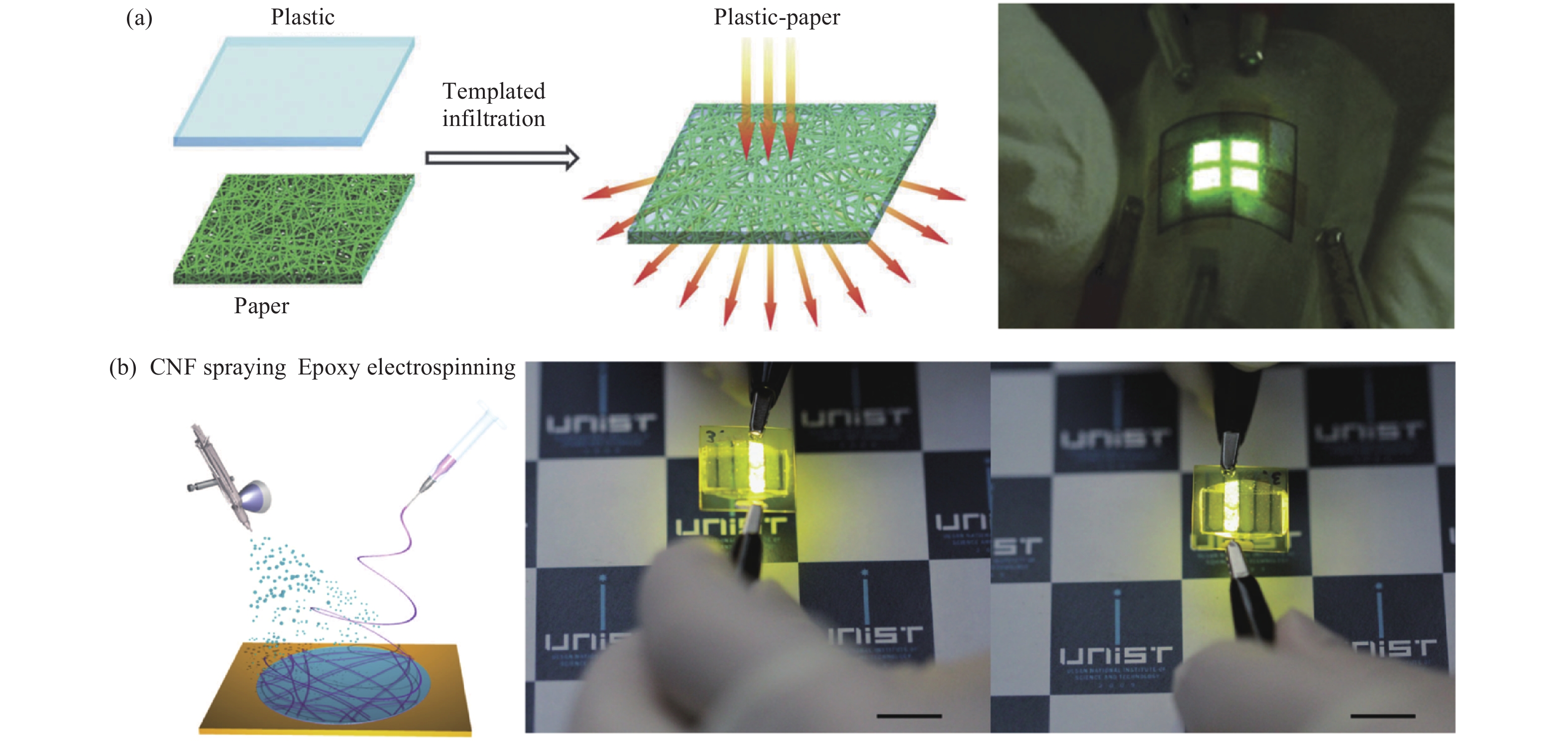
 DownLoad:
DownLoad:
